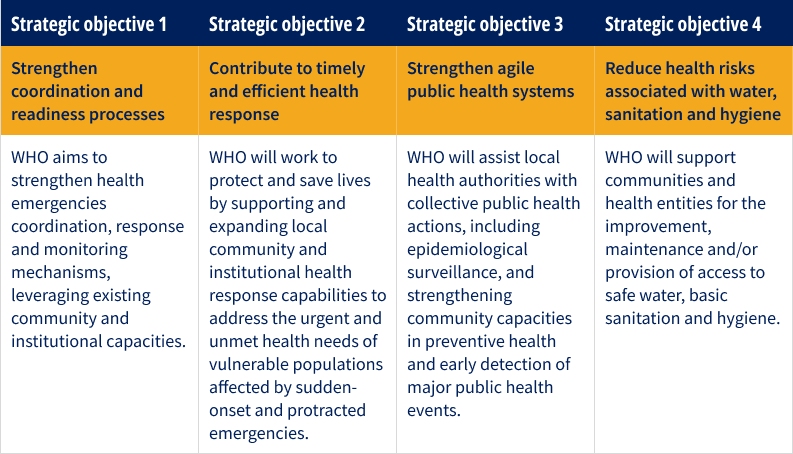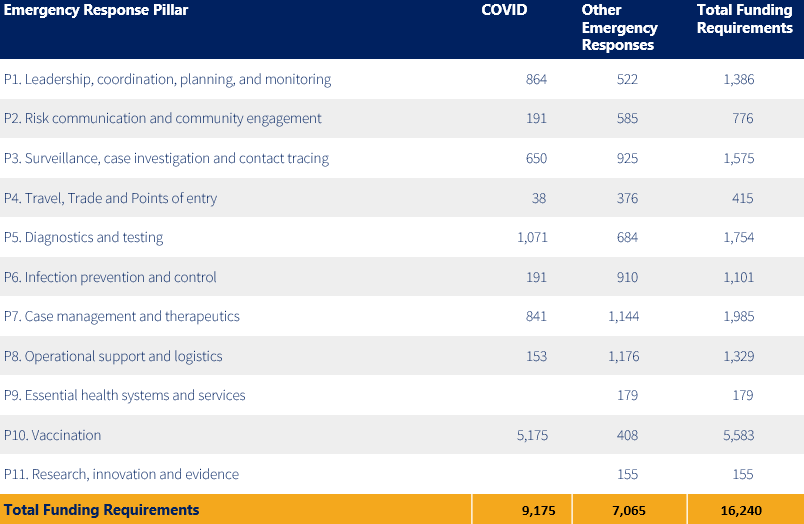
Colombia
Colombia
- People in need: 7.7 million1
- People targeted: 1.6 million
- People in need of health assistance: : 6 million
- Requirements (US$): 16.2 million
Context
Colombia is characterized by a fragile and prolonged humanitarian situation, which is notably affected by recurrent multiple hazards across different territories and serious structural and systemic challenges within the health system. Such chronic challenges have been aggravated by a series of recent shocks, including the COVID-19 pandemic, growing violence within the Colombian territories and along the border with Venezuela, as well as repetitive hydro-meteorological disasters over the last 12 months.
In 2022, the number of people in need of humanitarian assistance increased by 300 000 as a consequence of deteriorating indicators of maternal and child mortality, pregnancy in adolescent girls, HIV, suicides, sexually transmitted illnesses (STIs), gender-based and sexual violence and communicable diseases. Increasing population trends, primarily a result of mass migration, and the persistence of armed conflicts create mobility restrictions, forced displacement and access barriers to the provision of essential health services. The combination of these issues further impacts the health, lives and wellbeing of vulnerable populations. In many territories, the provision of appropriate health care is further hindered by geographical distance to health facilities and attacks against medical missions.
In 2022, increased heavy rainfall from the beginning of the first rainy season (which lasts from mid-March to June), affected most of the Colombian territory, causing flash floods, landslides and a number of severe weather-related incidents, which resulted in human casualties and important infrastructural damage. In October 2022, the National Disaster Risk Management (UNGRD per its acronym in Spanish) declared a national disaster situation as a result of the acute humanitarian impact caused by the second rainy season influenced by the ‘La Niña’ phenomenon. Official reports state that 289 municipalities, located in 26 departments, declared a public disaster.
Internal displacement and confinement remain a major barrier to accessing essential services such as health care for vulnerable Colombian populations. An estimated 104 800 people were affected in 2022 by mobility restrictions due to the armed conflict and over 174 000 have suffered from violent events. This represents an increase of 90% compared to the previous year. Forced displacement is also on the rise and is indicative of a worrying trend associated with the intensification of the armed conflict, causing almost 70 000 people to leave their homes this year. Beyond mobility restrictions, weak local health networks and the limited presence of state health facilities in many territories results in long distances between rural areas and health centers, seriously reducing access to health. Nationwide, it is estimated that at least eight million people in Colombia have limited access to health services, which are located more than one hour from where they live.
Humanitarian needs in Colombia are anticipated to increase in 2023, with a sharpening of the humanitarian impact in the country and the intensification of armed actions in the Pacific and northwestern regions and border area territories.
Emergency response
The health sector’s response strategy in Colombia focuses mainly on two objectives:
- Contributing to the reduction of avoidable morbidity and mortality rates through effective access to essential health services for the population affected by emergencies and situations of violence; and
- Strengthening community capacities to promote primary health care, first response, epidemiological surveillance and active participation in decision-making regarding health issues.
WHO efforts are aimed at protecting and saving lives by supporting and expanding local health emergency coordination, readiness, response and monitoring capacities to address the urgent and unmet needs of vulnerable populations impacted by sudden and prolonged emergencies. The emphasis will be placed on rural territories, with little or no access to health institutions, and confined communities.
Considering the multiplicity of humanitarian emergencies Colombia, and the diversity of regional dynamics, it is key to promote the delivery of comprehensive humanitarian health assistance in prioritized geographical areas and prioritized populations. Efforts will support the preparation, coordination and delivery of health services to the most vulnerable communities in a complementary manner to the services offered by state institutions. This will help ensure the delivery of comprehensive care, including primary health care, sexual and reproductive health, care for chronic non-communicable diseases, mental health, support to routine and COVID-19 vaccination and care for gender-based violence.
WHO will also assist local health authorities in collective public health actionsincludingepidemiological surveillance and community capacity-building in preventive health, and early detection of major public health events. Considering the cultural diversity of the country and the disproportionate impact of humanitarian emergencies on ethnic groups, needs-oriented intercultural approaches involving traditional specialists, midwives and community agents in the provision of indirect care are key. Recognizing and valuing the responsibility of the state to guarantee the protection of people as the first responder in an emergency, WHO will also continue to strengthen effective mechanisms that allow for better articulation and efficient coordination of the multiple humanitarian health actors in the country
Strategic objectives


Key activities
- Scale-up emergency readiness, response and coordination mechanisms and capacities.
- Strengthen contingency plans, activation and operationalization of national and territorial coordination spaces and the reinforcement of community capacities for first response, primary health care delivery and public health surveillance.
- Expand local community and institutional health response capabilities, including support for the deployment of the health response in affected communities and low complexity adaptations to health facilities to support operations during and after an emergency.
- Support local health authorities in strengthening early warning and response, public health surveillance networks, laboratory diagnosis of major infectious events with epidemic and pandemic potential and information management.
- Implement low complexity technical solutions that improve access to safe water and adequate basic sanitation and hygiene conditions.
- Implement technical support for the strengthening of environmental health, solid waste management and disease prevention.
Funding requirements
Overall country funding requirements, including COVID-19, by pillar (US$ ‘000)


Success Stories
Protecting the lives of displaced people in times of COVID-19
In April 2021, clashes between the Bolivarian National Air Force and an organized criminal group in Venezuela meant municipalities such as Arauquita, in Arauca, faced a massive influx of displaced people into their territory.
As a result of the clashes, just over 1 800 displaced families including children, young people and pregnant mothers, arrived in Arauquita with nothing but the clothes on their back. With the support of partner organizations, the municipal authority set up 57 emergency transitional shelters for the victims of this displacement, in order to provide urgent access to food, education, protection and in particular, health care. PAHO/WHO provided additional support to help increase available human resources and capacity building of health personnel.
They strengthened our knowledge, infrastructure, equipment and above all, they supported us with people with great human warmth," says Karen Ortiz, a public health surveillance professional in Arauquita.
Following coordination between local authorities and PAHO/WHO experts, a communication strategy was implemented to encourage the displaced population to remain in the shelter, where they could receive comprehensive life-saving care. The strategy was successful and well received by the population.
A coordinated strategy was developed with support of the Health Cluster and the Territorial Health Board, resulting in structured and unified action to provide health and mental health care in the context of emergencies. A community surveillance strategy was also implemented to characterize the demographic, epidemiological and health situation of the population living in the shelters.
During the following months, PAHO/WHO continued to follow-up on the response activities in the city and provide technical support for their development.
For more information
Mauricio Cerpa | Health Emergencies Advisor | PAHO/WHO Colombia | cerpamau@paho.org
Images

